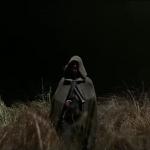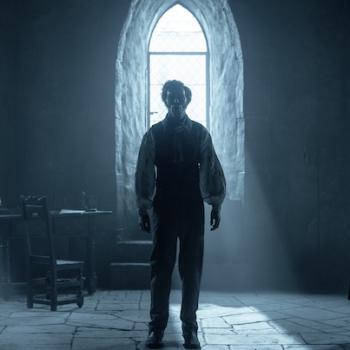
From King Arthur: Legend of the Sword, photo courtesy Warner Bros.
A Savior Comes
Even in the early parts of Arthur’s journey, there are allusions to him being a Christ-like savior for the British people. Vortigern resembles Herod more than pharaoh, frankly, wanting explicitly to kill this would-be king, and taking some pretty extreme measures to do so. Like Jesus, Arthur flees his home and lives in relative obscurity—a nobody in a backwater province. And just as Jesus hid His own true lineage, so Arthur tries to hide his (albeit for more selfish reasons).
But then Vortigern threatens to kill the prostitutes who raised him—sinners. He says that unless Arthur submits to the chopping block, they’ll die.
Arthur agrees to die for them, and Vortigern makes a huge deal about how Arthur will be scorned and demeaned before his death by the headsman. “Behold!” one of Vortigern’s lackeys cries. “The man who pulled sword from stone!” Frankly, it wouldn’t have felt out of character for Vortigern to slap a mocking crown on Arthur’s head before the execution—one that might read, sarcastically, “King of the Britons.” And Arthur’s willing to accept it all.
But the story has other plans. Arthur is not sacrificed, but rescued (via highly improbable means). He’s sent to “the darklands” to grapple with his own demons (perhaps an echo of Jesus in the wilderness, confronting the devil) before beginning his mission in earnest.
Now, Arthur is certainly no saint, and he’s leagues away from acting much like Jesus otherwise. But in terms of his position in the story—his relationship to Vortigern and his standing with his people—Arthur is a messiah-like figure.
And then, when he reaches the end of his quest and his enemy lies vanquished before him, Arthur blesses him. It’s a curious moment in a curious film, and not altogether consistent with anything. But if Ritchie wanted to suggest that Arthur was some sort of Christ-like figure, he couldn’t have done it much more explicitly.
There’s yet one more element to talk about in this discussion. Throughout Vortigern’s crumbling kingdom, the graffiti sign of resistance is what looks to be a small letter “t” stuck on the top of a circle. The symbol looks like a crude sword-in-the-stone, of course: The top of the “t” serving as the sword’s grip and crossguard, the bottom its blade and the circle being the stone itself. But it also looks like the thing on the right:
It’s called the globus cruciger, or the orb and cross, and it’s been a symbol of royal authority for centuries. Indeed, it was first seen on coins as far back as the early 400s. It’s symbolism is explicitly Christian, of course: The orb itself represents the world or, more broadly, the cosmos. The cross on top represents Christ’s supremacy over all.
Yes, King Arthur: Legend of the Sword is a rather silly movie. But it hides a certain resonancy that, for all its overlay of silliness, is rather profound.













